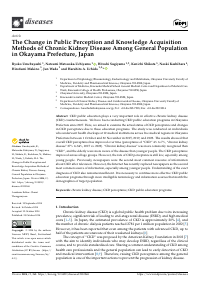The Change in Public Perception and Knowledge Acquisition Methods of Chronic Kidney Disease Among General Population in Okayama Prefecture, Japan
Permalink : http://escholarship.lib.okayama-u.ac.jp/67750
| FullText URL | |
| Author |
Umebayashi, Ryoko
Department of Nephrology, Rheumatology, Endocrinology and Metabolism, Okayama University Faculty of Medicine, Dentistry and Pharmaceutical Sciences
Matsuoka-Uchiyama, Natsumi
Department of Nephrology, Rheumatology, Endocrinology and Metabolism, Okayama University Faculty of Medicine, Dentistry and Pharmaceutical Sciences
Sugiyama, Hitoshi
Department of Nephrology, Rheumatology, Endocrinology and Metabolism, Okayama University Faculty of Medicine, Dentistry and Pharmaceutical Sciences
ORCID
Kaken ID
publons
researchmap
Kashihara, Naoki
Kawasaki Geriatric Medical Center
Wada, Jun
Department of Nephrology, Rheumatology, Endocrinology and Metabolism, Okayama University Faculty of Medicine, Dentistry and Pharmaceutical Sciences
ORCID
Kaken ID
publons
researchmap
Uchida, Haruhito A.
Department of Nephrology, Rheumatology, Endocrinology and Metabolism, Okayama University Faculty of Medicine, Dentistry and Pharmaceutical Sciences
|
| Abstract | CKD public education plays a very important role in effective chronic kidney disease (CKD) countermeasure. We have been conducting CKD public education programs in Okayama Prefecture since 2007. Here, we aimed to examine the actual status of CKD perceptance and changes in CKD perceptance due to these education programs. The study was conducted on individuals who underwent health checkups at 12 medical institutions across five medical regions in Okayama Prefecture between 1 October and 30 November in 2015, 2019, and 2023. The results showed that overall CKD perceptance has improved over time (perceptance of "CKD" 4% to 7%, "chronic kidney disease" 27% to 34%, 2015 vs. 2023). "Chronic kidney disease" was more commonly recognized than "CKD", and the elderly were more aware of the disease than younger people. The CKD perceptance improved across all age groups. However, the rate of CKD perceptance is still low, especially among young people. Previously, newspapers were the second most common resource of information about CKD after television. However, the Internet has recently replaced newspapers as the second most common source of information, especially among younger people. Understanding of the exact diagnosis of CKD also remains insufficient. It is necessary to continue more effective CKD public education programs through more intelligible terminology and information sources that match the demographics of target population.
|
| Keywords | chronic kidney disease
CKD perceptance
CKD public education programs
|
| Published Date | 2024-10-25
|
| Publication Title |
Diseases
|
| Volume | volume12
|
| Issue | issue11
|
| Publisher | MDPI
|
| Start Page | 268
|
| ISSN | 2079-9721
|
| Content Type |
Journal Article
|
| language |
English
|
| OAI-PMH Set |
岡山大学
|
| Copyright Holders | © 2024 by the authors.
|
| File Version | publisher
|
| DOI | |
| Web of Science KeyUT | |
| Related Url | isVersionOf https://doi.org/10.3390/diseases12110268
|
| License | https://creativecommons.org/licenses/by/4.0/
|
| Citation | Umebayashi, R.; Matsuoka-Uchiyama, N.; Sugiyama, H.; Shikata, K.; Kashihara, N.; Makino, H.; Wada, J.; Uchida, H.A. The Change in Public Perception and Knowledge Acquisition Methods of Chronic Kidney Disease Among General Population in Okayama Prefecture, Japan. Diseases 2024, 12, 268. https://doi.org/10.3390/diseases12110268
|
| Funder Name |
Ministry of Health, Labour and Welfare of Japan
|
| 助成番号 | JPMH22FD1001
|
